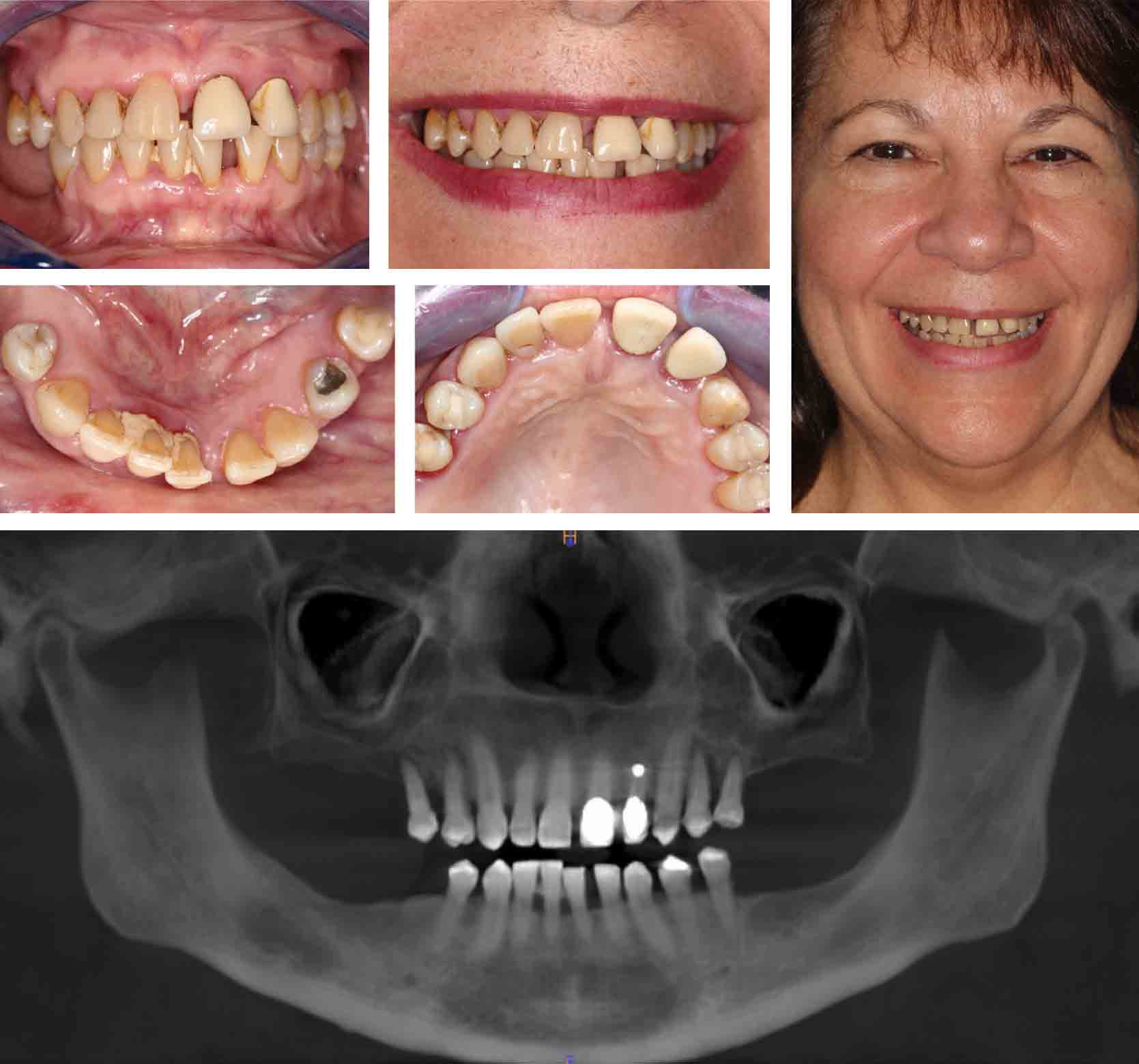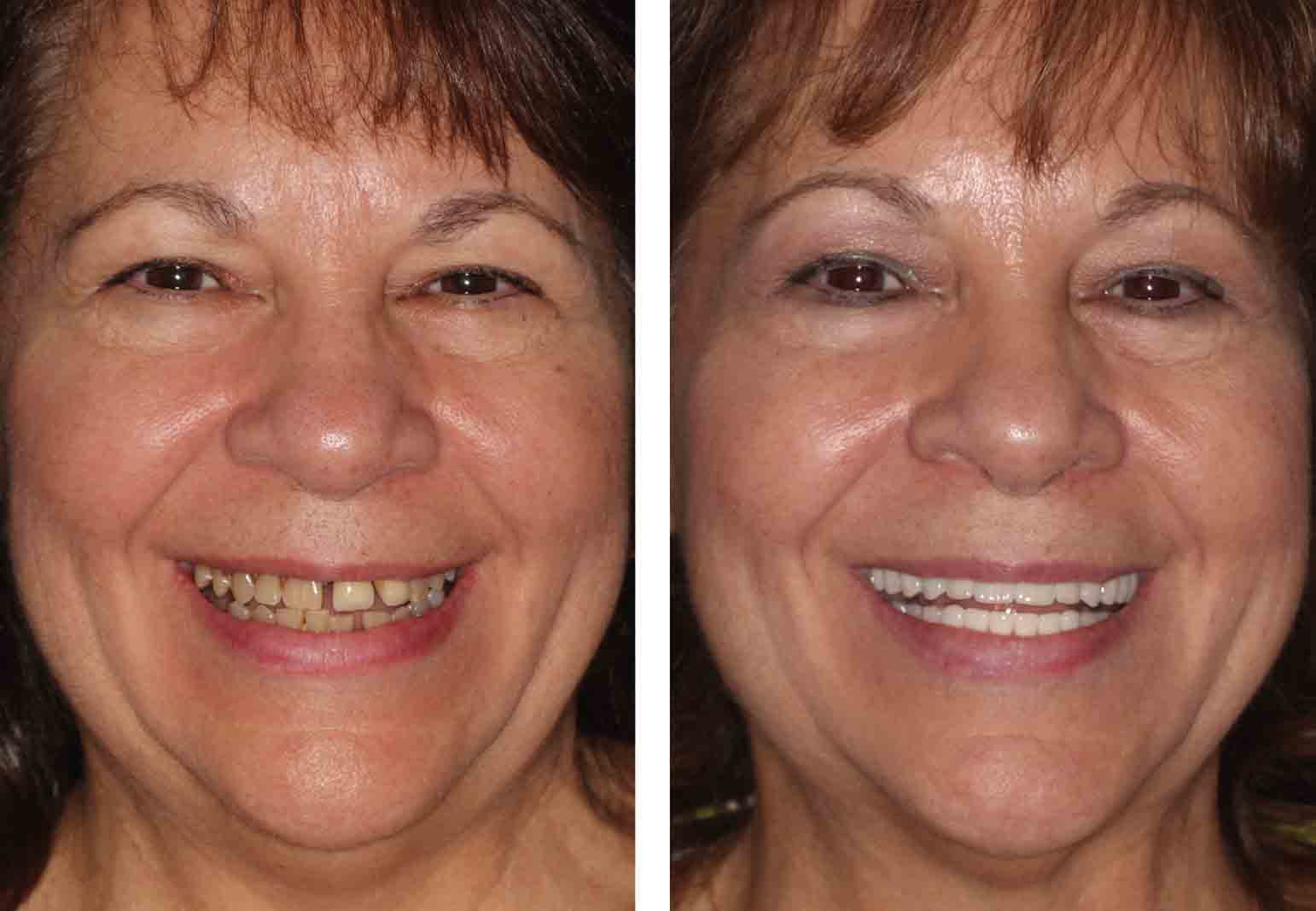Editor’s intro: Dr. Pikos experienced tremendous feedback regarding the patient’s quality of life and self-image improvement following immediate full-arch reconstruction using Same Day Teeth®/nSequence® Guided Prosthetics™ protocol.
Dr. Michael A. Pikos describes a treatment plan for patients who request quick results
This is a 59-year-old Caucasian female, Joanne, who presented to the office with chief complaint of “I hate my teeth; there are spaces, and they look bad.” Present medical history is essentially unremarkable. Patient is a nonsmoker.

Clinical and CBCT evaluation revealed the following pertinent findings:
Maxilla — Partially pneumatized sinuses without evidence of pathology was noted. Teeth Nos. 3-13 are present with varying degrees of vertical bone loss present particularly with teeth Nos. 4, 5, 12, 13.
Mandible — Teeth Nos. 20-28 are present again in varying degrees of vertical bone loss present with spacing between several teeth. Remainder of oral as well as head and neck exam was within normal limits. In summary, diagnosis was consistent with Class II deep bite with splayed maxillary dentition secondary to collapse of vertical dimension and loss of posterior mandibular dentition and moderate-severe periodontal disease.
Joanne was given several treatment options that included serial extractions followed by root form implant placement for fixed work. This would also include restoration of existing teeth. Another option presented included serial extractions and RPD appliances. The third option was the Same Day Teeth® protocol for both arches. Joanne was very adamant about wanting “new teeth,” and thus, we proceeded with addressing both arches with the Same Day Teeth®/nSequence® Guided Prosthetics™ protocol for immediate full-arch reconstruction.






Comprehensive evaluation and record taking was done followed by an online meeting with nSequence® along with our restorative and surgical team. Subsequently, two-jaw surgery was proposed, and as you will see from the images, shown on page 20, the virtual treatment planning was accomplished followed by subsequent surgery at which time the conventional nSequence® Guided Prosthetics™ protocol was followed with appropriate bone foundation guides, surgical guides, and placement of implants via a fully guided approach. Subsequently, the maxillary and mandibular long-term fixed provisionals were placed. You will also note the 4-year follow-up with radiographs and clinical results. Five implants were placed in the maxilla followed by a full-arch zirconium hybrid final prosthesis, and four implants were placed in the mandible followed by a full-arch acrylic-wrap hybrid prosthesis.
Without question, we, as clinicians, were able to experience tremendous feedback from Joanne in that her quality of life changed dramatically, and in fact, her self-image was transformed remarkably as is true for so many of our patients treated with this wonderful technology.







In summary, there are at least the following seven advantages that this fully guided full-arch immediate approach has over the conventional analog based conversion protocol.
- 3D precision planning and virtual workup
- Optimal interdisciplinary treatment planning — (restorative, surgical, lab) (collaborative accountability)
- Fewer patient appointments
- Less chair time (1.5-3 hours per arch)
- Stronger material — titanium reinforced PMMA provisional
- Predictable, patient-specific, affordable
- Excellent professional documentation (medical/legal)
Implant Practice US offers CEs such as this to learn more about immediate full-arch reconstruction. To read about another predictable novel treatment modality for treating failing dentitions, edentulous, and potentially edentulous patients, see this article. Subscribers can get CE credits after taking the quiz!
Stay Relevant With Implant Practice US
Join our email list for CE courses and webinars, articles and mores

 Michael A. Pikos, DDS, is originally from Campbell, Ohio. He attended The Ohio State University where he graduated Summa Cum Laude and Phi Beta Kappa. He also graduated with honors from the Ohio State University College of Dentistry. Dr. Pikos completed an internship at Miami Valley Hospital and residency training in Oral and Maxillofacial Surgery at the University of Pittsburgh, Montefiore Hospital. He is a Diplomate of the American Board of Oral and Maxillofacial Surgery, Diplomate of the American Board of Oral Implantology/Implant Dentistry, Diplomate of the International Congress of Oral Implantologists, and a Fellow of the American College of Dentists. Dr. Pikos is the recipient of the 2006 Aaron Gershkoff Memorial Award from the American Academy of Implant Dentistry, and the 2015 Saul Schluger Memorial Award for Top Educator. Dr. Pikos has extensive experience in implant surgery and hard and soft tissue procedures. He also emphasizes interactive CT technology along with foundational principles of prosthetics and biomechanics that dictate the ultimate success of comprehensive implant rehabilitation. Dr. Pikos is founder and CEO of the Pikos Institute. Since 1990, he has been teaching advanced bone and soft tissue grafting courses with alumni who now number more than 3,700 from all 50 states and 43 countries. Dr. Pikos maintains a private practice, which is limited exclusively to implant surgery in Trinity, Florida.
Michael A. Pikos, DDS, is originally from Campbell, Ohio. He attended The Ohio State University where he graduated Summa Cum Laude and Phi Beta Kappa. He also graduated with honors from the Ohio State University College of Dentistry. Dr. Pikos completed an internship at Miami Valley Hospital and residency training in Oral and Maxillofacial Surgery at the University of Pittsburgh, Montefiore Hospital. He is a Diplomate of the American Board of Oral and Maxillofacial Surgery, Diplomate of the American Board of Oral Implantology/Implant Dentistry, Diplomate of the International Congress of Oral Implantologists, and a Fellow of the American College of Dentists. Dr. Pikos is the recipient of the 2006 Aaron Gershkoff Memorial Award from the American Academy of Implant Dentistry, and the 2015 Saul Schluger Memorial Award for Top Educator. Dr. Pikos has extensive experience in implant surgery and hard and soft tissue procedures. He also emphasizes interactive CT technology along with foundational principles of prosthetics and biomechanics that dictate the ultimate success of comprehensive implant rehabilitation. Dr. Pikos is founder and CEO of the Pikos Institute. Since 1990, he has been teaching advanced bone and soft tissue grafting courses with alumni who now number more than 3,700 from all 50 states and 43 countries. Dr. Pikos maintains a private practice, which is limited exclusively to implant surgery in Trinity, Florida.

